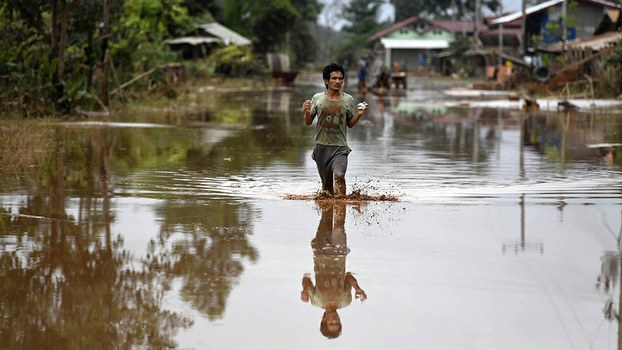Lao Dam Collapse Due to Use of Soil: Water Experts
Source: RFA
Poor construction methods, with soil used in place of concrete, caused a fatal hydropower dam collapse last year in Laos, a panel of water experts has concluded, prompting a rejection of its findings by the South Korean firm that built the project.
The disaster occurred on July 23, 2018 when a saddle dam at the Xe Pian Xe Namnoy (PNPC) hydropower project collapsed following heavy rains, inundating 12 villages and killing at least 40 people in Champassak and Attapeu provinces, leaving many more missing.
On Tuesday, the government of Laos confirmed earlier reports that a panel of international experts had determined the construction of the saddle dam was “substandard,” and the soil used to build it was “the cause of the collapse,” according to state media.
“The International Expert Panel (IEP) found that the major cause of the Xe Pian Xe Namnoy dam collapse was the high-absorbency of the foundation of saddle dam D, coupled with soil being porous and easily eroded, and the level of rising water,” Singpheth Bounsavathiphanh, vice chairman of the Government Inspection Authority and vice chairman of the Lao National Investigation Committee told reporters in Vientiane.
“Those conditions caused erosion within the foundation … When the erosion reached a certain level, the dam became unstable and sliding began at the higher saddle dams. At some point, saddle dam D broke, causing a massive amount of water to flow out of the reservoir.”
Earlier this month, an official with the dam project told RFA on condition of anonymity that the IEP had determined the dam collapse was the result of poor construction and the use of soil instead of concrete in a report it submitted to the Lao government in March, which also recommended that all other saddle dams at the site of the disaster be built with concrete.
At the time, Singpheth Bounsavathiphanh told RFA that government officials had received the report in March, but couldn’t disclose its findings “because they are in the process of negotiating with the South Korean government about what information should or should not be released to the public.”
PNPC is a consortium formed by a local Lao company and South Korea’s SK Engineering & Construction, and Korean involvement in the project had earlier prompted Seoul to send relief teams to Laos to help mitigate the effects of the disaster.
Findings rejected
Shortly after the release of the report on Tuesday, SK Engineering & Construction dismissed the IEP’s findings and questioned the scientific basis of its approach.
“The IEP itself conducted soil analysis through its designated location, methodology and third-party analysis and the final data did not [support its conclusion],” a spokesperson told South Korean media.
“If the destruction was a result of what the IEP claimed, a large amount of soil leakage should have been found at the bottom of the saddle dam before the accident, but that was not the case.”
SK Engineering & Construction noted that teams sent by both the South Korean government and by a group of leading engineering firms to investigate the cause of disaster, at the behest of the government of Laos, “initially had different opinions” from those included in the IEP report.
“Unlike the IEP, the teams have suggested that the cause of the accident is difficult to determine,” the spokesperson said.
In the meantime, a new saddle dam is now under construction at a location a little more than a kilometer (two-thirds of a mile) away from the dam that failed, and officials have said that the new 400-meter-long (1,312-foot-long) structure will be built with concrete and anchored at a depth of at least 10 meters (33 feet) into the ground.
In the wake of the Xe Pian Xe Namnoy disaster, Laos has stepped up scrutiny of an ambitious hydropower dam building program under which it aims to serve as the “battery of Asia” and sell hydropower to its more industrialized neighbors China, Thailand and others.
Reported and translated by Max Avary for RFA’s Lao Service. Written in English by Joshua Lipes.


